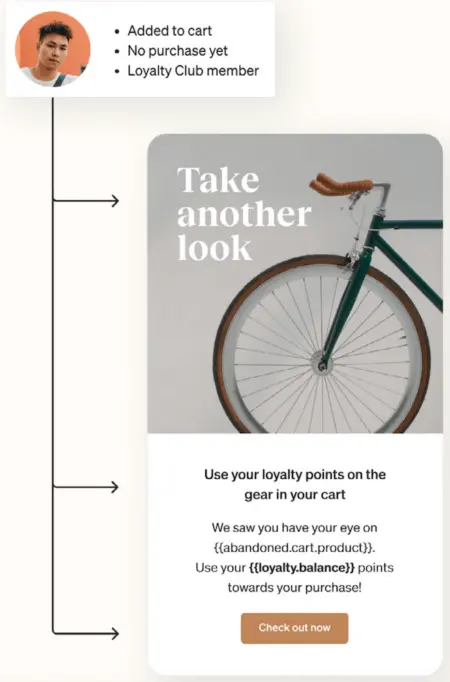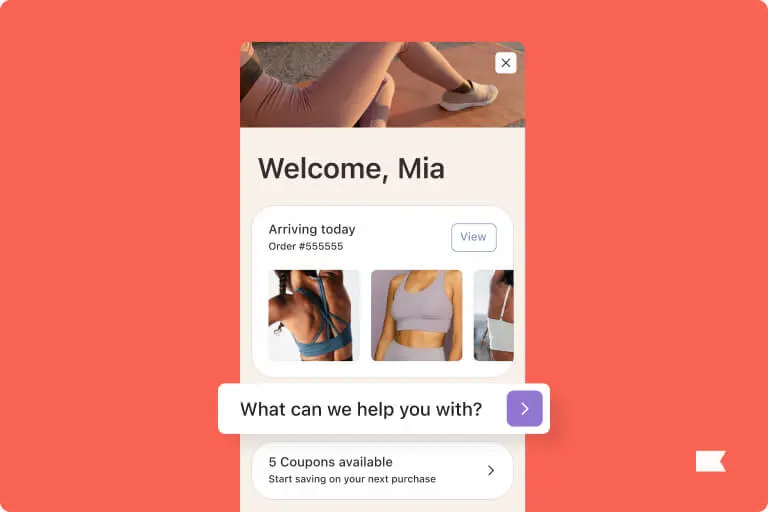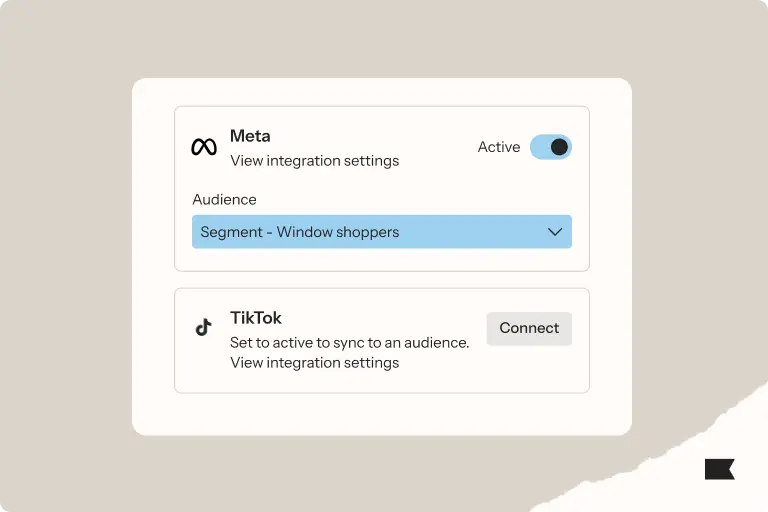Behavioral segmentation examples: 10 advanced segments for increasing engagement and conversion

In the 3-step process of how behavioral targeting works, behavioral segmentation is the bridge that connects the insights you learn from mining the data you have on your customers to the content you share with them.
As Devin Bhatia, principal customer success manager at Klaviyo, points out, behavioral segmentation gives you a vehicle for “listening to your audience, understanding their preferences, and reaching out to them with relevant content they’re actually interested in.”
Basic behavioral customer segmentation draws from 5 main categories of customer behavior data: website behavior, purchase behavior, customer lifecycle behavior, interest-related behavior, and customer satisfaction behavior.
Behavioral segmentation is about listening to your audience, understanding their preferences, and reaching out to them with relevant content they’re actually interested in.
But the most granular behavioral segmentation—and “true 1:1 marketing,” says Jon Palmer, lead product marketing manager at Klaviyo—involves organizing your audience into segments based on behavioral data from multiple categories, then activating that data into highly personalized experiences.
Here, we break down 10 advanced behavioral segmentation examples that go beyond the basics. Each customer behavior segmentation idea you see here combines several types of behavioral data from an ethical owned channel, and is based on real-life Klaviyo use cases.
Read on for inspiration on advanced customer behavior segmentation, and to learn how to fine-tune the messaging and content you’re sharing through your marketing channels.
1. Site visitors who are subscribed to your email list
You never want to show an email sign-up form to someone who’s landed on your ecommerce site by clicking through an email. People in this behavioral segment are already on your email marketing list, so the pop-up is redundant, and it won’t accomplish anything beyond disrupting the subscriber’s user experience on your website.
In Klaviyo, you can create a targeted SMS sign-up form that displays only when the person visiting your website is a known email subscriber. You can also try a pop-up form that invites them to join your loyalty program, if they aren’t already signed up.
“The ability to target on-site forms based on the segment someone’s in is big,” Palmer says. “And it’s not common outside of Klaviyo.”

Your turn: Visit our Help Center to learn how to target email subscribers with pop-up forms in Klaviyo.
2. Site visitors from a specific acquisition source
Sign-up forms are a great way to encourage your site visitors to subscribe to your email and SMS content. But different sign-up forms will appeal to different people based on where they are in the customer journey.
Let’s say you’re partnering with an influencer on a top-of-funnel digital marketing campaign, and you’ve built out a special landing page at a vanity URL where the influencer is sending their audience. “You can launch a specific pop-up for that page only,” Palmer suggests.
Bonus: In Klaviyo, you can also launch a unique welcome series depending on where a new subscriber signs up for your list. For people in the above behavioral segment example, “you might have a welcome series that includes a 20-second video of the influencer endorsing your company,” Palmer says.
Your turn: Visit our Help Center to learn how to target forms to specific URLs in Klaviyo.
3. Email subscribers who clicked in the last 72 hours but have not placed an order
The people in this behavioral segment are clearly engaged with your brand—they might just need a little extra encouragement to cross over into customer territory.
This is an ideal time to experiment with a move Bhatia calls the “espresso shot”: Re-send the same email to the subscribers who clicked, but didn’t buy.
Wait—the exact same email? Yes, Bhatia explains: “You can update the subject line, but you don’t have to. The only reason you’d have to change any of the content is if it was advertising a limited-time deal that’s no longer applicable.”
Otherwise, “it’s the exact same content,” Bhatia says. And across industry verticals, the results are “unbelievable,” he adds: 40%+ open rates, up to 10% click rates, and 30–50% the revenue of a standard email campaign.
The espresso shot represents the Klaviyo philosophy in a nutshell—we want to send fewer emails, and we want to send better emails, and we want to send to people who are engaged with our brand.
Why does such a simple approach work so well as an additional revenue capture tool? Bhatia believes it represents “the Klaviyo philosophy in a nutshell—we want to send fewer emails, and we want to send better emails, and we want to send to people who are engaged with our brand.”
“There’s a segment of users who click an email, but then life happens—whatever it is. And sometimes they just need that reminder,” Bhatia explains. “So when they get the email again, they’re like, ‘Oh yeah, I remember clicking and going to the website—I didn’t make that order, but now I’m ready to do that.’”
Your turn: Visit Klaviyo Community to learn more about how to set up an espresso shot of your own.
4. Subscribers who add a product to their cart, but do not proceed to check-out
One behavioral marketing automation “that’s not always done and is incredibly powerful,” says Lucina Kress Rowe, principal customer success manager at Klaviyo, is an add-to-cart abandonment flow.
Don’t confuse this with the more common browse abandonment flow or abandoned cart flow, Kress Rowe cautions: “They’re all different, and they all hit people at a slightly different point in their decision-making journey.”
Here’s how the abandonment flows differ from each other:
- Browse abandonment: triggered when someone views a product page, but does not add a product to their cart
- Add-to-cart abandonment: triggered when someone adds a product to their cart, but does not proceed to check-out
- Abandoned cart: triggered when someone adds a product to their cart and proceeds to check-out, but does not complete their purchase
“This is the beauty of the customer journey touchpoints,” Kress Rowe points out. “Everybody’s busy. Everybody’s jumping between modes of transportation, they’re going to work, they’re going to run errands, they’re picking up their kids from school—they’re distracted, whatever it is. We are living in the age of distraction. People are going to forget what path they were on.”
“It’s nice from time to time, especially when you don’t have heavy brand recognition, to be able to give someone a friendly reminder,” she adds. “Days later, if someone needs the product but can’t remember which one they liked, they want that email or text. It’s really powerful and it’s really important.”
And in Kress Rowe’s experience, every time she suggests a Klaviyo user implements add-to-cart abandonment, “it’s only a net gain.”
“People assume, ‘OK, I’ve got my browse abandonment and I’ve got my abandoned cart—if I do add-to-cart abandonment, it’s just going to pull revenue from the other two,’” Kress Rowe says. “But it doesn’t. It silos those people who have taken that specific action and then stopped cold. We set up the flow filters so they’re mutually exclusive, so there’s no overlap.”

Your turn: Visit Klaviyo Community to learn more about the custom metrics involved in setting up an add-to-cart abandonment flow, and visit our Help Center to troubleshoot added-to-cart tracking.
5. Customers who only purchase during BFCM
These people “really like their deals,” Bhatia says, “but they haven’t purchased at all otherwise. So this is a special audience that’s probably only going to purchase once a year.”
Unlike many competing platforms which delete user data after 90–180 days, Klaviyo doesn’t archive historical customer data—which makes it possible to build a behavioral segment of customers who shop with you consistently, but only over the holidays.
Bhatia suggests sending this segment an email right before BFCM that acknowledges how much they appreciate a deal—and highlights your biggest upcoming promotions for the holiday.
Your turn: Visit our Help Center to learn how to create a holiday shoppers segment in Klaviyo.
6. Customers who purchased a specific product in the last year
Launching a new version of a popular product? “Create a behavioral segment of individuals who purchased that specific product, and let them know a v2 is now available,” Bhatia suggests.
“You probably want everyone to know about your new product,” Kress Rowe acknowledges. But the idea here, she says, is that based on what customers have bought in the past or even just viewed or added to cart, “you want some people to know about it even more than others.”
Similarly, you might reach out to a segment of customers who purchased a specific product with another product that goes particularly well with the first one. Try sending a cross-sell or up-sell email or text message with personalized product recommendations catered to the customer’s most recent purchase behavior.
“Let’s say they bought pants—offer them a shirt or complementary product. But get really granular and specific,” Palmer advises. “It’s not just ‘Hey, just you placed an order—come back and purchase again.’ It’s, ‘OK, people who bought that exact product you bought and gave it a 5-star review also love this.’”

Your turn: Visit our Help Center to learn how to use product recommendations in your marketing.
7. Customers who bought a specific product and left a review, either positive or negative
Maybe your customers have been raving about your hero product, and you’re releasing it in a new color this month. Palmer recommends creating a behavioral segment of customers who not only bought this exact SKU in any color, but also gave it a 4- or 5-star review.
“Then, when you make your new product announcement email, you’re going to have a different variation of the campaign for that segment that says something like, ‘The product you love in a new color,’” he explains.

Similarly, maybe your recent ecommerce reviews reveal some constructive criticism about one of your products, and you’ve now addressed those concerns in a new and improved version of it.
Take the same approach, but this time, segment based on anyone who left a 3-star review or lower. In your customized product announcement, promise, “We heard you.”
Your turn: Visit our Help Center to learn how to understand Klaviyo Reviews data so you can use it in your customer behavior segmentation.
8. SMS subscribers who have purchased 2x in 6 months and spent at least 3x your AOV
This is how Bhatia defines VIPs. “That should be around 1–2% of your list,” he points out. “If everyone’s a VIP, then no one’s a VIP.”
VIP behavioral segmentation is particularly effective in the SMS channel, because sharing a phone number is a lot more intimate than sharing an email address.
“These are really special people,” Bhatia adds. “Try giving them special opportunities, whether it’s a teaser for a new product that’s coming out or early access to this product you know is going to sell out.”
When Ohio-based apparel brand HOMAGE, for example, wanted to promote their new 80s- and 90s-style NFL Starter jackets, they released a hype video encouraging customers who wanted to be first in line for the new jackets to opt in to SMS.
Then, they used SMS to offer exclusive updates and drive excitement among their loyal fanbase, offering first dibs on jackets to those who texted “STARTER”.
It was the brand’s very first SMS campaign—and it drummed up 100 orders in the first hour alone. According to Nathan Okuley, VP of brand marketing, the buying process was so easy, customer service calls actually declined—despite the massive volume of traffic during the product drop.
Klaviyo unlocked for us the modern way to shop. There was a feeling and a rush for customers to have access to something and in such a simple way.
Ultimately, 86.9% of SMS customers clicked the in-message link, and 9% of fans placed an order. Even more impressive: The campaign delivered $167 in revenue per recipient.
“Klaviyo unlocked for us the modern way to shop,” Okuley says. “There was a feeling and a rush for customers to have access to something and in such a simple way.”
Your turn: Visit our Help Center to learn how to create an SMS VIP segment in Klaviyo.
9. Customers with high CLTV who aren’t subscribed
Let’s say you have a segment of customers who are not subscribed to email or SMS, but are placing orders regularly and have an above-average CLTV. “They’re good customers—you just can’t reach them on those owned channels,” Palmer explains.
Palmer recommends a layered behavioral targeting approach that uses first-party data to attempt to reach those customers on multiple channels outside of email and SMS, from social media to direct mail.
First, push that segment of email addresses to Facebook or Google Ads, and keep an eye on your conversion rates. “That’s a more expensive channel than email and SMS, but it’s not as expensive as direct mail,” Palmer explains.
When you do this in Klaviyo, you can either find people who are similar to the email addresses, also known as a lookalike audience, or you can retarget to the exact email addresses in the segment you pushed out (as long as the email addresses match across platforms).
Next, create a new segment of the profiles that didn’t convert on Facebook or Google, and send a piece of direct mail marketing to the addresses you have on file from the last time they placed an order.

“It’s prioritizing based on channel cost, as well as based on the customer’s behavior in terms of purchase history, and their lack of behavior in terms of not engaging with email or SMS or even social,” Palmer explains.
Your turn: Visit our Help Center to learn how to get started with Facebook Advertising in Klaviyo.
10. Customers with high CLTV who are at a high risk of churn
No matter how sophisticated your marketing is, even your best customers might leave you in the end. But what if you could reach out at the exact moment someone is likely to drop off?
“You can’t go in and look at millions of profiles manually and pick out the people who are at risk,” Palmer points out. “You need something to help you scale that digestion of the data and the subsequent personalization.”
Klaviyo’s suite of AI-powered predictive analytics includes predicted CLTV, predicted next order date, predicted demographics, predicted spending potential, and predicted churn risk. And Palmer notes that “you don’t need a whole data science team to do it.”
In Klaviyo, predictive analytics are “marketer-enabled,” Palmer explains. “You can use them in segmentation and automation as a dropdown option, just like you would any other information that lives on the profile.”
In Klaviyo, you don’t need a whole data science team to do it.
With the churn risk property, for example, you might trigger a flow when a lapsed but high-CLTV customer is above a 60% risk of churn “and give them a larger discount,” Palmer suggests. “You wouldn’t normally give this discount other than Black Friday, but it’s June and you don’t want to lose this person, so you’re going to give them your kitchen sink offer.”
Your turn: Visit our Help Center to learn how to segment based on predictive analytics in Klaviyo.

Related content

Discover how ecommerce personalisation enhances customer experiences and boosts revenue with real examples and proven strategies.

Discover how one brand used Klaviyo’s Meta integration to build high-intent audiences, lower CPA, and drive 2x conversions through smarter ad targeting.

Learn how to use Klaviyo’s advanced CDP to drive more revenue this BFCM—from real-time personalization and enriched profiles to warehouse syncs, alerts, and custom segmentation.